Intel Centrino/Pentium-M Notebook Roundup: Dell, FIC and IBM Examined
by Matthew Witheiler on March 12, 2003 11:22 AM EST- Posted in
- Laptops
Dell Latitude D800 - Under the Hood (continued)
The bottom of the D800's motherboard is home to a number of items. First are a set of SODIMM slots used to house the D800's memory. Our unit came configured with two sticks of 256MB PC2100 DDR memory. As mentioned before, this left no open expansion slots available for use at a later date; at least 256MB of system memory must be removed in order to increase the memory size.
Also mentioned before is the ICH4 derived south bridge located on the bottom of the motherboard.
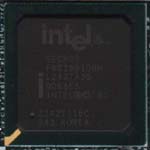
The mini-PCI slot on the D800 can be configured with a number of wireless options. In our sample unit the slot contained a Intel 802.11b wireless module. The use of the Intel wireless card in the system made the D800 we reviewed a Centrino system, as opposed to a Pentium M solution because the system uses the three components necessary to gain the Centrino name: the Pentium M processor, the 855PM chipset, and an Intel wireless card. The wireless card in our system was marked as an "engineering gold sample" meaning it was a pre-production card and thus had no model number markings on it. The card offers two antenna connections and the D800 utilizes both of them with antennas located in the area around the LCD panel.
There is a small wire coming off the notebook on the front right side. What is that for, you may ask? That is for Dell's Bluetooth module. Our system came configured with the Bluetooth module which sits in the front left side of the system right, to the left of the left speaker. It amazed us to see how small Dell was able to make the Bluetooth device. As you can see below, the module is barely the size of a penny and includes both the transmitter/receiver and the antenna.
Below you can see the back of the motherboard in its full glory.
We noticed something odd on the motherboard between the SODIMM slots and the mini-PCI slot. It appears that the D800's motherboard, or at least the sample that we got, is not quite yet ready for prime time: the motherboard has been reworked with a small red wire. We encountered no problems when using the unit but it not likely that any Latitude D800s will ship without a proper motherboard fix especially considering Dell's past respect for a polished product (proper does not include hand soldering each motherboard).
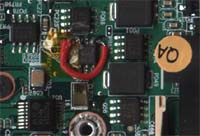
The hard drive that our Inspiron D800 used was a




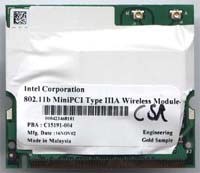
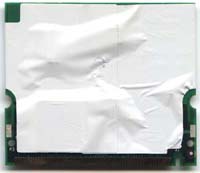
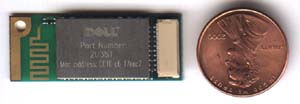

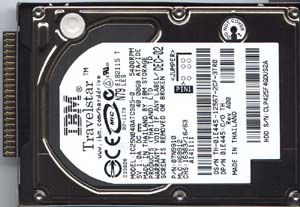








3 Comments
View All Comments
builda - Thursday, February 2, 2006 - link
There appears to be a wide spread fault with the Gigabyte NB-1401 model notebook, where it reports having system disk errors or cannot find the hard disk. We have 7 of this model notebook and now 6 of them have reported the same problem. After running chkdsk to temporarily repair the errors that had been caused on the harddisk I found the problem returned the escalated to the point the harddisk could not be found. I further checked using Hitachi drive fitness testing tool which reported a cable error on each machine. Originally I returned 3 of these for repair as they were just outside the warranty period and the supplier checked with Gigabyte with the fix being to rub the cable all over with an eraser!! This worked for a short period but the problem has returned a couple of months later and has spread (like a virus) it now affects 6 out of the 7 notebooks. The supplier has just gone into administration and my next step is to approach Gigabyte who's support service has been found to be extremely unresponsive in the recent past.dbiberdorf - Tuesday, July 27, 2004 - link
I beg to differ with the reviewer. The keyboard on this unit is mediocre, and the track stick buttons are an abomination. They sit too low in the case and have too much travel. It makes my thumbs hurt after a while, and I often have to press them with a finger to get them to activate fully.The most powerful notebook in the world loses big points in my book if they built-in keyboard and pointing devices are weak. Certainly it's the case here. Dell, please figure out how to buy good keyboards for your machines!
Finally, the power adapter, while featuring convienent wrap-around cabling, is phenomenally large. My cordless phone at home is smaller. With the large profile of the machine, the adapter has to go in a side pocket of the carrying case, adding a little more bulge to your day.
visibilityunlimited - Thursday, October 30, 2003 - link
Screen resolution beyond SXGA+ would be unreadable using Windows for example while being more readable using Linux.Both the Linux text console and graphics mode X-windows-system screen drivers can be fully customized to display text at any resolution. The text characters could easily be displayed with current software at 1200dpi or more (if only the graphics processors and monitors could operate at that speed) and still retain the current character size. Text can currently be generated from vector based Type I and TrueType fonts for rasterizing at any resolution. Image scaling is a different and very easy problem.
The Windows OS is the real culprit holding back general usage of higher resolutions and typeset quality displays because of the OS being handicapped by the inertia of antique display modes. Darn. I want 3200x2400 or more!